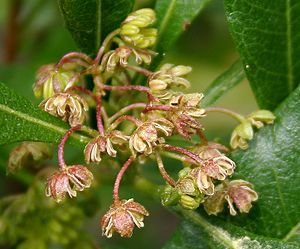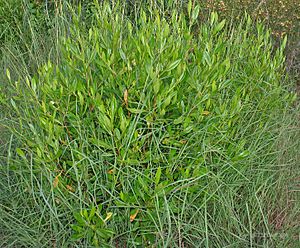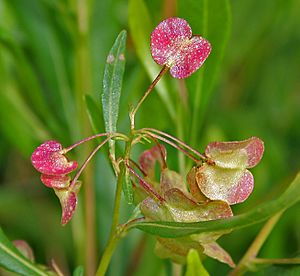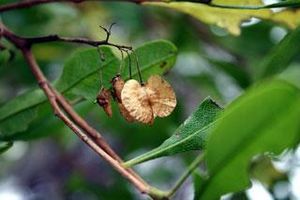Broadleaf hopbush facts for kids
Quick facts for kids Broadleaf hopbush |
|
|---|---|
 |
|
| flowers | |
| Conservation status | |
| Scientific classification | |
| Genus: |
Dodonaea
|
| Species: |
viscosa
|
The Dodonaea viscosa is a type of flowering plant in the soapberry family. It grows in many parts of the world, including tropical, subtropical, and warm temperate areas. You can find it in Africa, the Americas, southern Asia (like Pakistan), and Australasia.
Contents
What Does It Look Like?
The Dodonaea viscosa is usually a shrub that grows about 1 to 3 meters (3 to 10 feet) tall. Sometimes, it can even become a small tree, reaching up to 9 meters (30 feet) tall.
Its leaves are about 4 to 7.5 cm (1.5 to 3 inches) long. They are often sticky because they produce a special resin. The leaves are tough and leathery, and their edges can be wavy or have small teeth.
The plant has yellow to orange-red flowers. These flowers grow in clusters called panicles. Interestingly, some plants only have male flowers, while others only have female flowers. Sometimes, a plant might have both! The wind helps to carry the pollen from one flower to another.
After the flowers, the plant grows a fruit that looks like a capsule. It's about 1.5 cm (0.6 inches) wide and has two to four wings. These fruits start out red and turn brown as they get older.
Different Names for the Plant
This plant is often called hopbush. This name is used for this specific plant and for other plants in the same group.
People in different places have their own names for it:
- In Pakistan, it's called sanata (سناتھا) in Urdu and ghurhaski (غواړاسکې) in Pashto.
- In the south Indian state of Tamil Nadu, it's known as virāli (விராலி).
- In Australia, it has many names like broad leaf hopbush, sticky hopbush, and native hop.
- In Hawaiian language, it's called ʻaʻaliʻi.
- In New Zealand, it's known as akeake.
- In Uruguay and Argentina, it's called chirca.
- In Mexico, it can be called romerillo or jarilla.
How People Use It
The wood of the Dodonaea viscosa is very strong and lasts a long time. In New Zealand, the Māori used this wood to make weapons, walking sticks, and handles for axes.
People in New Guinea, Southeast Asia, West Africa, and Brazil use the wood for building houses and as firewood. The leaves can also be used as a type of bandage for wounds.
The Native Hawaiians used the wood to make house posts, fishing lures, and digging sticks. They also made a red dye from the fruit.
A special type of Dodonaea viscosa called 'Purpurea' has purple leaves. It's often grown in gardens as a pretty shrub. This plant is very tough. It can grow in open areas and is good at handling salty soil, dry weather, and pollution. Because it can stand strong winds, it's often used to create hedges or windbreaks.
The Seri in Mexico use the plant in traditional medicine. In Africa and Asia, it was used to help with stomach problems, skin issues, and pain in joints. In New Guinea, people sometimes burn it like incense during funerals. Long ago, Australians even used Dodonaea viscosa instead of hops to brew beer, which is how it got the name "hopbush"!
Growing Dodonaea viscosa
You can grow Dodonaea viscosa from seeds. Sometimes, the seeds need to be soaked in very hot water first to help them sprout. You can also grow new plants by taking cuttings from an existing plant. This is a good way to get female plants if you want their interesting winged fruits for decoration. The hopbush can survive long dry periods and doesn't need a lot of care to grow well.
- Dressler, S.; Schmidt, M.; Zizka, G. (2014). "Dodonaea viscosa". African plants – a Photo Guide. Frankfurt/Main: Forschungsinstitut Senckenberg. http://www.africanplants.senckenberg.de/root/index.php?submitForm=true&page_id=77&searchTextMenue=Dodonaea+viscosa&filterRegionIDs%5B%5D=6&filterRegionIDs%5B%5D=1&filterRegionIDs%5B%5D=2&filterRegionIDs%5B%5D=3&filterRegionIDs%5B%5D=5.
See also
 In Spanish: Dodonaea viscosa para niños
In Spanish: Dodonaea viscosa para niños






